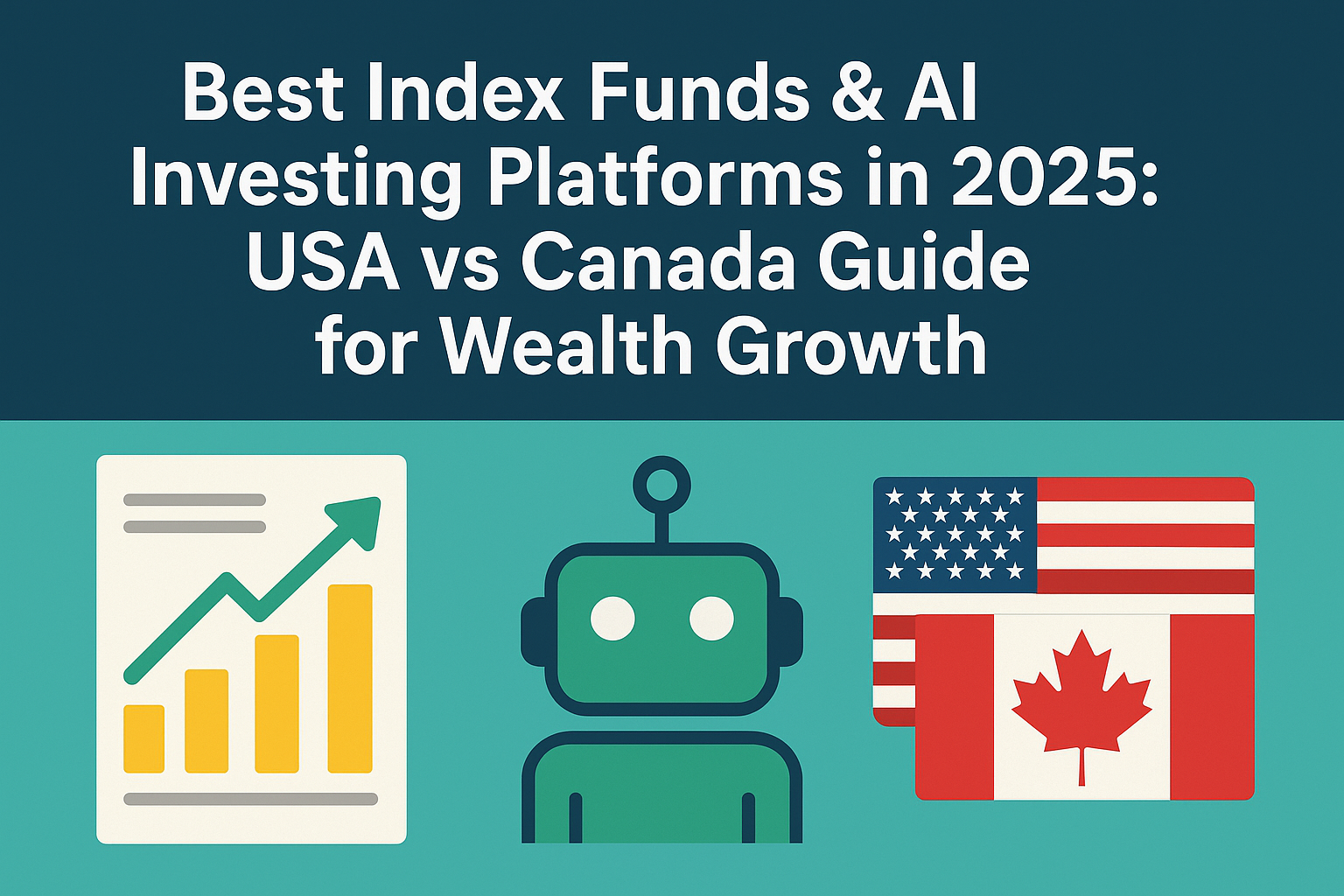Best Index Funds and ETFs to Invest in 2025 (USA vs Canada)
Only have $100 to invest? In 2025, that’s more than enough to start building wealth with index funds and ETFs. The investment landscape has evolved dramatically, making it easier than ever for beginners in both the USA and Canada to access low-cost, diversified investment options. This guide breaks down the top index funds, ETFs, and platforms to help you make informed decisions regardless of which side of the border you call home.

Why Index Funds & ETFs Remain the Smartest Investment in 2025
Index funds and ETFs continue to dominate the investment landscape in 2025 for good reason. These investment vehicles track market indexes like the S&P 500 or TSX Composite, offering instant diversification across hundreds of companies with a single purchase.
Lower Fees, Higher Returns
The average expense ratio for actively managed mutual funds hovers around 0.66%, while many index funds charge less than 0.1%. This fee difference might seem small, but compounds significantly over time. According to recent data, index funds outperform about 80% of actively managed funds over a 10-year period, largely due to their lower fee structure.
Passive Income Potential
Many index funds and ETFs pay regular dividends, creating a steady stream of passive income. Dividend-focused ETFs in particular can generate yields between 2-4% annually, providing both growth and income. This dual benefit makes them particularly attractive for long-term wealth building.

“The simplest way to invest remains buying the entire market at the lowest possible cost and holding it forever. Index funds make this easier than ever before.”
Best Index Funds & ETFs for USA Investors in 2025
American investors have access to some of the world’s most efficient and lowest-cost index funds. Here are the standout performers for 2025:
Vanguard Total Stock Market ETF (VTI)

Expense Ratio: 0.03%
Holdings: 3,500+ US stocks across all market caps
Why It’s Great: Complete US market exposure with rock-bottom fees. This fund gives you instant diversification across the entire US economy.
S&P 500 ETF (SPY)

Expense Ratio: 0.09%
Holdings: 500 largest US companies
Why It’s Great: The gold standard of index investing, offering exposure to approximately 80% of the US market by capitalization.
Schwab U.S. Dividend Equity ETF (SCHD)

Expense Ratio: 0.06%
Holdings: 100+ high-quality dividend-paying US companies
Why It’s Great: Combines growth with income, focusing on companies with strong fundamentals and consistent dividend growth.
Tax Tip for US Investors: Consider holding your index funds and ETFs in tax-advantaged accounts like Roth IRAs to maximize growth potential. For 2025, the Roth IRA contribution limit is $7,000 ($8,000 if you’re 50 or older).
Best Index Funds & ETFs for Canadian Investors in 2025
Canadian investors have their own set of excellent index funds and ETFs tailored to the Canadian market. Here are the top performers for 2025:
Vanguard FTSE Canada All Cap Index ETF (VCN)

Expense Ratio: 0.05%
Holdings: 190+ Canadian stocks across all market caps
Why It’s Great: Comprehensive exposure to the entire Canadian equity market at a minimal cost.
iShares S&P/TSX 60 Index ETF (XIU)

Expense Ratio: 0.16%
Holdings: 60 largest Canadian companies
Why It’s Great: Canada’s oldest and most liquid ETF, providing exposure to blue-chip Canadian companies.
BMO Canadian Dividend ETF (ZDV)

Expense Ratio: 0.33%
Holdings: 50+ dividend-paying Canadian companies
Why It’s Great: Focuses on high-quality Canadian dividend payers with sustainable yields and growth potential.
TFSA Advantage: Canadian investors should consider holding index ETFs in a Tax-Free Savings Account (TFSA). For 2025, the TFSA contribution limit is $7,000, allowing your investments to grow completely tax-free.
USA vs Canada Index Funds: Key Differences
| Feature | USA Index Funds | Canada Index Funds |
| Average Expense Ratio | 0.03% – 0.10% | 0.05% – 0.25% |
| Market Size | Larger, more diverse market | Smaller, more concentrated in financials and resources |
| Tax-Advantaged Accounts | 401(k), Roth IRA, Traditional IRA | TFSA, RRSP, RESP |
| Dividend Withholding | No withholding for US citizens | 15% withholding on US dividends (except in RRSP) |
| Currency Considerations | USD-denominated | CAD-denominated with CAD-hedged options |
Top AI-Powered Investing Platforms in 2025
The investment landscape has evolved with artificial intelligence now playing a crucial role in portfolio management. These platforms use AI to optimize asset allocation, minimize fees, and maximize returns based on your risk profile.

Wealthsimple (Canada)
Minimum Investment: $0
Fees: 0.4-0.5% management fee
AI Features: Automated rebalancing, tax-loss harvesting, ESG scoring
Best For: Canadian investors looking for a fully-managed ETF portfolio with socially responsible options.
Robinhood (USA)
Minimum Investment: $1
Fees: $0 commission trading
AI Features: AI-powered investment signals, fractional shares, automated investing
Best For: US investors who want commission-free trading with fractional share options.
Questrade (Canada)
Minimum Investment: $1,000 for Questwealth portfolios
Fees: 0.25% management fee for robo-advisor, or $4.95-$9.95 per trade for self-directed
AI Features: Questwealth AI-driven portfolios, automated rebalancing
Best For: Canadian investors who want both robo-advisor and self-directed options.
Ready to let AI optimize your investments?
AI-powered platforms can help you build a diversified portfolio of index funds and ETFs tailored to your goals.
Start Investing with AIHow to Start Investing with Just $100 in 2025

Step 1: Choose the Right Account
For Canadians: Open a TFSA with Wealthsimple or Questrade. All growth inside this account is completely tax-free.
For Americans: Start with a Roth IRA through Robinhood or Vanguard. Contributions grow tax-free and withdrawals in retirement are tax-free.
Step 2: Select Low-Cost Index ETFs
With $100 in the USA: Buy fractional shares of VTI (Vanguard Total Stock Market) or SPY (S&P 500 ETF).
With $100 in Canada: Use Wealthsimple Trade to buy XEQT (iShares Core Equity ETF) with no commission.
Step 3: Set Up Automatic Contributions
Even $25-50 per month adds up significantly over time. Most platforms allow you to schedule automatic deposits from your bank account.
Step 4: Reinvest All Dividends
Enable dividend reinvestment (DRIP) to automatically purchase more shares when dividends are paid, accelerating your compound growth.
“The most powerful force in the universe is compound interest. Starting with just $100 and adding $50 monthly to a low-cost index fund could grow to over $50,000 in 25 years at a 7% average return.”
TFSA vs Roth IRA: Best Tax-Advantaged Accounts Compared
Understanding the tax-advantaged accounts available in your country is crucial for maximizing your investment returns from index funds and ETFs.
| Feature | TFSA (Canada) | Roth IRA (USA) |
| 2025 Contribution Limit | $7,000 annual | $7,000 annual ($8,000 if 50+) |
| Tax on Contributions | After-tax dollars | After-tax dollars |
| Tax on Withdrawals | Tax-free anytime | Tax-free after age 59½ |
| Income Restrictions | None | Phase-out starts at $146,000 (single) or $230,000 (married) |
| Withdrawal Flexibility | Withdraw anytime with no penalty | Contributions can be withdrawn anytime; earnings subject to rules |
| Ideal For | Short and long-term goals | Retirement focused |

Building a Diversified Portfolio in 2025: Sample Allocation
Here’s a balanced portfolio approach for beginners looking to invest in index funds and ETFs in 2025:

Conservative Portfolio
- 40% Broad Market Index Funds
- 30% Bond ETFs
- 20% Dividend ETFs
- 10% Cash/Money Market
Risk Level: Low
Best For: Investors nearing retirement or with low risk tolerance
Balanced Portfolio
- 60% Broad Market Index Funds
- 20% International ETFs
- 15% Bond ETFs
- 5% Cash/Money Market
Risk Level: Medium
Best For: Most investors with 5+ year time horizon
Aggressive Growth Portfolio
- 70% Broad Market Index Funds
- 20% Sector/Thematic ETFs
- 10% International ETFs
- 0% Bonds/Cash
Risk Level: High
Best For: Young investors with 10+ year time horizon
Risk Tolerance Tip: Don’t invest money you’ll need within the next 3-5 years in stock index funds. Market volatility can lead to short-term losses, but historically rewards patient, long-term investors.
2025 Investment Platform Comparison: USA vs Canada
| Feature | Wealthsimple (CA) | Robinhood (USA) | Questrade (CA) |
| Fees | 0.4-0.5% management fee | $0 commission trading | 0.25% management fee or $4.95-$9.95 per trade |
| Minimum Investment | $0 | $1 (fractional shares) | $1,000 for managed, $0 for self-directed |
| AI Features | Robo-advisor, ESG scoring | AI signals, automated investing | Questwealth portfolios |
| Tax-Advantaged Accounts | TFSA, RRSP, RESP | Roth IRA, Traditional IRA | TFSA, RRSP, RESP, LIRA |
| Fractional Shares | Yes | Yes | No |
| Mobile App Rating | 4.8/5 | 4.2/5 | 4.1/5 |
Ready to start your investment journey?
Open an account with one of these top platforms and begin building your index fund portfolio with as little as $100.
Start Small, Stay Consistent: Your Path to Wealth in 2025
The best index funds and ETFs in 2025 offer unprecedented access to market growth with minimal fees. Whether you’re in the USA with options like VTI and SPY, or in Canada with VCN and XIU, the key is to start now—even with just $100.
Remember that consistency trumps timing. Set up automatic contributions, reinvest your dividends, and leverage tax-advantaged accounts like TFSAs or Roth IRAs. The combination of low-cost index funds and modern AI-powered platforms creates a powerful wealth-building engine that works while you sleep.

Don’t wait to start building wealth
Open an account today and make your first $100 investment in index funds. Your future self will thank you.
Start Investing Now
















































